
Hoje o post será sobre como criar uma replica do MySQL no Azure, seguem os passos que usei para criar a replica de leitura e alta disponibilidade.
Server Master = datasqlbrasil
Server Replica = datasqlargentinaCriei um database chamado teste com uma tabela chamada tabela1 no MySQL primário:
mysql -u cesar -h datasqlbrasil.mysql.database.azure.com -p'password'
Welcome to the MariaDB monitor. Commands end with ; or \g.
Your MySQL connection id is 23
Server version: 8.0.37-azure Source distribution
Copyright (c) 2000, 2018, Oracle, MariaDB Corporation Ab and others.
Type 'help;' or '\h' for help. Type '\c' to clear the current input statement.
MySQL [(none)]>
MySQL [(none)]> SELECT version();
+--------------+
| version() |
+--------------+
| 8.0.37-azure |
+--------------+
1 row in set (0,150 sec)
MySQL [(none)]> CREATE DATABASE teste;
Query OK, 1 row affected (0,162 sec)
MySQL [(none)]> show databases;
+--------------------+
| Database |
+--------------------+
| information_schema |
| mysql |
| performance_schema |
| sys |
| teste |
+--------------------+
5 rows in set (0,150 sec)
MySQL [(none)]> use teste;
Database changed
MySQL [teste]>
MySQL [teste]> create table teste.tabela1 (code VARCHAR(255), active VARCHAR(255), total VARCHAR(255), data DATETIME);Realizei uma carga de 100 registros para popular o database teste:
for i in {1..100}; do mysql -u cesar -h datasqlbrasil.mysql.database.azure.com -p'password' -e "INSERT INTO teste.tabela1 (code, active, total,data) VALUES ($i, 1, 1,Now());"; done
Verificiando a carga de dados:
MySQL [teste]> SELECT COUNT(*) FROM teste.tabela1;
+----------+
| COUNT(*) |
+----------+
| 100 |
+----------+
1 row in set (0,151 sec)Criando a replica do MySQL com nome datasqlargentina:
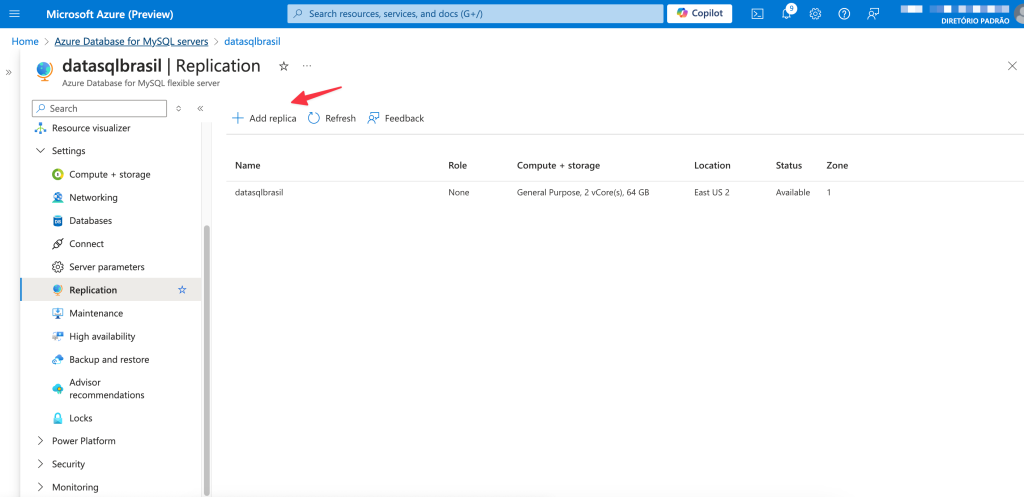
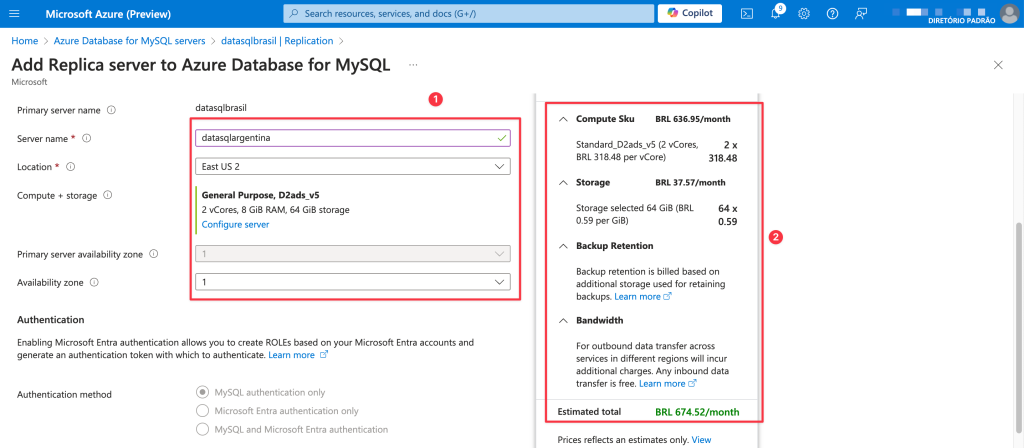
Alem das informações de criação da replica, ao lado direito podemos verificar o custo desta replica:
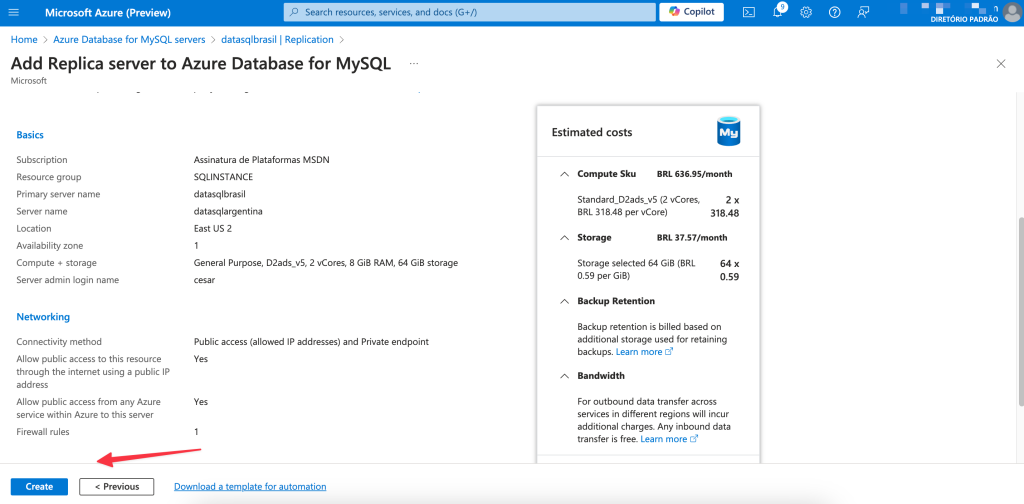
Replica datasqlargentina criada e disponivel para uso:
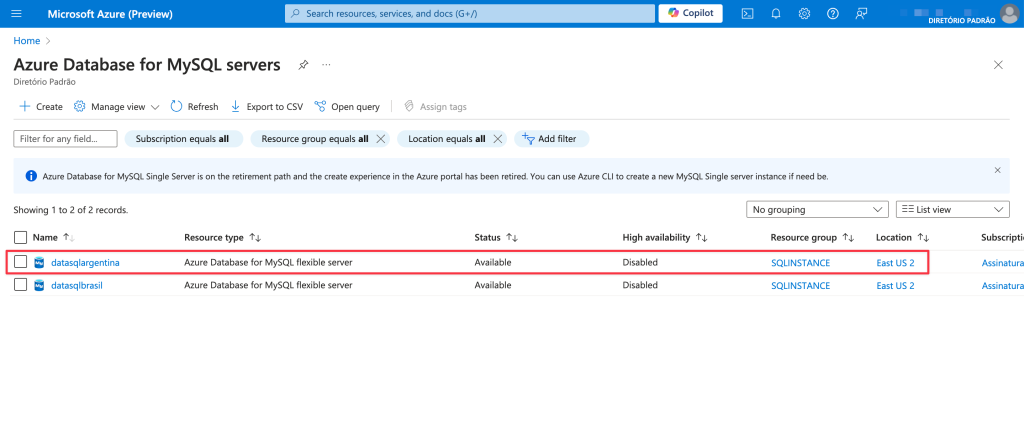
Verificando a role de cada servidor:
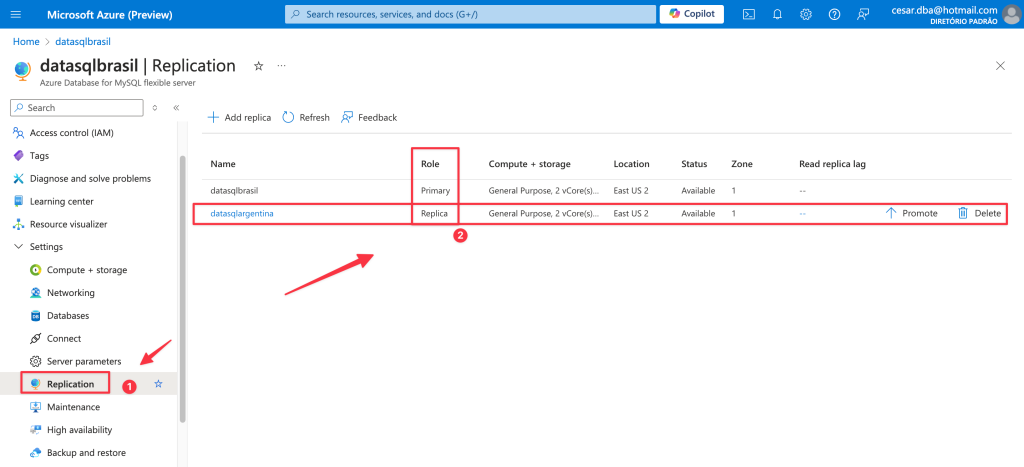
Conectando na replica datasqlargentina e fazendo um teste de escrita, como podemos ver a replica é apenas para leitura:
for i in {1..100}; do mysql -u cesar -h datasqlargentina.mysql.database.azure.com -p'password' -e "INSERT INTO teste.tabela1 (code, active, total,data) VALUES ($i, 1, 1,Now());"; done
ERROR 1290 (HY000) at line 1: The MySQL server is running with the --read-only option so it cannot execute this statement
ERROR 1290 (HY000) at line 1: The MySQL server is running with the --read-only option so it cannot execute this statement
ERROR 1290 (HY000) at line 1: The MySQL server is running with the --read-only option so it cannot execute this statement
ERROR 1290 (HY000) at line 1: The MySQL server is running with the --read-only option so it cannot execute this statement
ERROR 1290 (HY000) at line 1: The MySQL server is running with the --read-only option so it cannot execute this statement
ERROR 1290 (HY000) at line 1: The MySQL server is running with the --read-only option so it cannot execute this statement
ERROR 1290 (HY000) at line 1: The MySQL server is running with the --read-only option so it cannot execute this statement
ERROR 1290 (HY000) at line 1: The MySQL server is running with the --read-only option so it cannot execute this statement
ERROR 1290 (HY000) at line 1: The MySQL server is running with the --read-only option so it cannot execute this statement
ERROR 1290 (HY000) at line 1: The MySQL server is running with the --read-only option so it cannot execute this statement
ERROR 1290 (HY000) at line 1: The MySQL server is running with the --read-only option so it cannot execute this statement
ERROR 1290 (HY000) at line 1: The MySQL server is running with the --read-only option so it cannot execute this statement
ERROR 1290 (HY000) at line 1: The MySQL server is running with the --read-only option so it cannot execute this statement
ERROR 1290 (HY000) at line 1: The MySQL server is running with the --read-only option so it cannot execute this statement
ERROR 1290 (HY000) at line 1: The MySQL server is running with the --read-only option so it cannot execute this statement
ERROR 1290 (HY000) at line 1: The MySQL server is running with the --read-only option so it cannot execute this statement
ERROR 1290 (HY000) at line 1: The MySQL server is running with the --read-only option so it cannot execute this statement
ERROR 1290 (HY000) at line 1: The MySQL server is running with the --read-only option so it cannot execute this statement
ERROR 1290 (HY000) at line 1: The MySQL server is running with the --read-only option so it cannot execute this statement
ERROR 1290 (HY000) at line 1: The MySQL server is running with the --read-only option so it cannot execute this statement
ERROR 1290 (HY000) at line 1: The MySQL server is running with the --read-only option so it cannot execute this statement
ERROR 1290 (HY000) at line 1: The MySQL server is running with the --read-only option so it cannot execute this statement
ERROR 1290 (HY000) at line 1: The MySQL server is running with the --read-only option so it cannot execute this statement
ERROR 1290 (HY000) at line 1: The MySQL server is running with the --read-only option so it cannot execute this statement
ERROR 1290 (HY000) at line 1: The MySQL server is running with the --read-only option so it cannot execute this statement
ERROR 1290 (HY000) at line 1: The MySQL server is running with the --read-only option so it cannot execute this statement
ERROR 1290 (HY000) at line 1: The MySQL server is running with the --read-only option so it cannot execute this statement
ERROR 1290 (HY000) at line 1: The MySQL server is running with the --read-only option so it cannot execute this statement
ERROR 1290 (HY000) at line 1: The MySQL server is running with the --read-only option so it cannot execute this statement
ERROR 1290 (HY000) at line 1: The MySQL server is running with the --read-only option so it cannot execute this statement
ERROR 1290 (HY000) at line 1: The MySQL server is running with the --read-only option so it cannot execute this statement
ERROR 1290 (HY000) at line 1: The MySQL server is running with the --read-only option so it cannot execute this statementRealizando mais uma carga de 100 registros na master:
for i in {1..100}; do mysql -u cesar -h datasqlbrasil.mysql.database.azure.com -p'password' -e "INSERT INTO teste.tabela1 (code, active, total,data) VALUES ($i, 1, 1,Now());"; done
Verificando os registros inseridos na master:
MySQL [(none)]> SELECT COUNT(*) FROM teste.tabela1;
+----------+
| COUNT(*) |
+----------+
| 114 |
+----------+
1 row in set (0,145 sec)
MySQL [(none)]> SELECT COUNT(*) FROM teste.tabela1;
+----------+
| COUNT(*) |
+----------+
| 115 |
+----------+
1 row in set (0,171 sec)
MySQL [(none)]> SELECT COUNT(*) FROM teste.tabela1;
+----------+
| COUNT(*) |
+----------+
| 119 |
+----------+
1 row in set (0,144 sec)
MySQL [(none)]> SELECT COUNT(*) FROM teste.tabela1;
+----------+
| COUNT(*) |
+----------+
| 130 |
+----------+
1 row in set (0,145 sec)
MySQL [(none)]> SELECT COUNT(*) FROM teste.tabela1;
+----------+
| COUNT(*) |
+----------+
| 146 |
+----------+
1 row in set (0,145 sec)
MySQL [(none)]> SELECT COUNT(*) FROM teste.tabela1;
+----------+
| COUNT(*) |
+----------+
| 156 |
+----------+
1 row in set (0,146 sec)
MySQL [(none)]> SELECT COUNT(*) FROM teste.tabela1;
+----------+
| COUNT(*) |
+----------+
| 200 |
+----------+
1 row in set (0,146 sec)
Verificando os registros inseridos na replica:
MySQL [(none)]> SELECT COUNT(*) FROM teste.tabela1;
+----------+
| COUNT(*) |
+----------+
| 200 |
+----------+
1 row in set (0,146 sec)
Promovendo a replica datasqlargentina como primária:
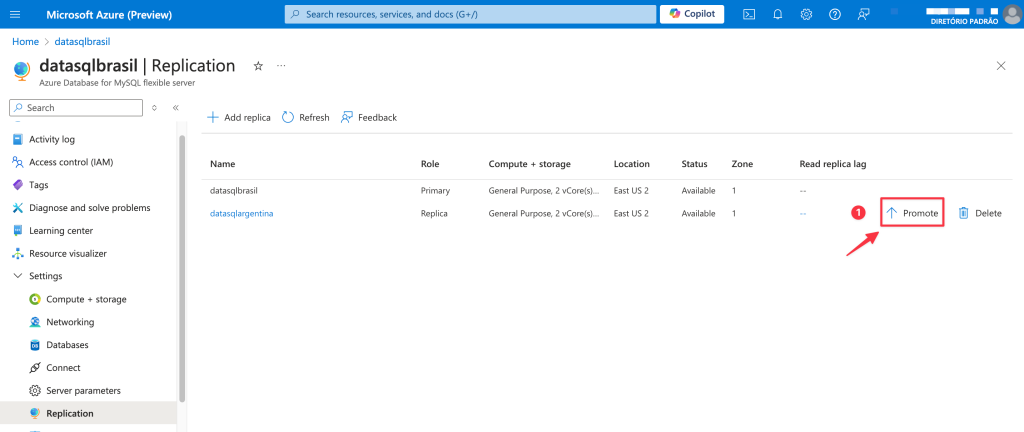
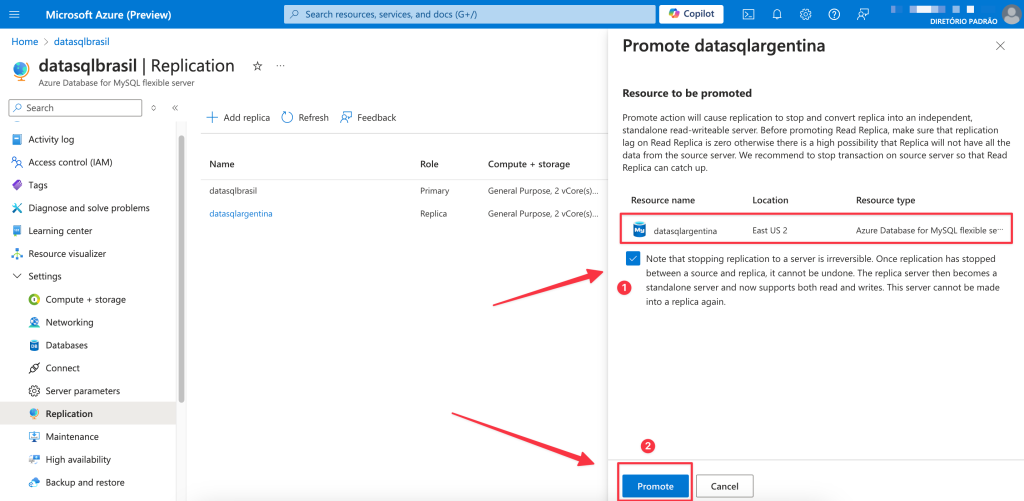
Realizando a carga de dados na replica promovida datasqlargentina:
for i in {1..100}; do mysql -u cesar -h datasqlargentina.mysql.database.azure.com -p'password' -e "INSERT INTO teste.tabela1 (code, active, total,data) VALUES ($i, 1, 1,Now());"; done
mysql -u cesar -h datasqlargentina.mysql.database.azure.com -p'password'
Welcome to the MariaDB monitor. Commands end with ; or \g.
Your MySQL connection id is 66
Server version: 8.0.37-azure Source distribution
Copyright (c) 2000, 2018, Oracle, MariaDB Corporation Ab and others.
Type 'help;' or '\h' for help. Type '\c' to clear the current input statement.
MySQL [(none)]> SELECT COUNT(*) FROM teste.tabela1;
+----------+
| COUNT(*) |
+----------+
| 218 |
+----------+
1 row in set (0,149 sec)
MySQL [(none)]> SELECT COUNT(*) FROM teste.tabela1;
+----------+
| COUNT(*) |
+----------+
| 220 |
+----------+
1 row in set (0,159 sec)
MySQL [(none)]> SELECT COUNT(*) FROM teste.tabela1;
+----------+
| COUNT(*) |
+----------+
| 300 |
+----------+
1 row in set (0,149 sec)
MySQL [(none)]>
Espero que esse post possa ajudar as pessoas que estão iniciando no MySQL com Azure.